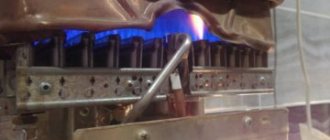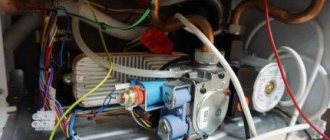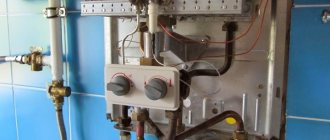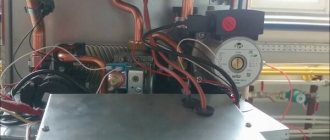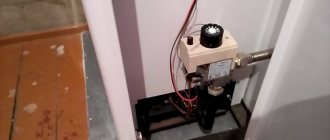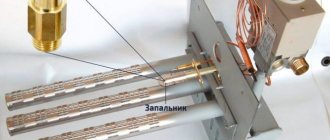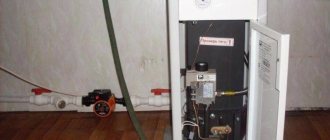Home / Gas boilers
Back
Published: 03/04/2020
Reading time: 7 min
0
4317
The Danko brand is known in the CIS countries for its gas boilers. The first Danko boiler was produced in the Ukrainian city of Rivne in 2002.
Today the company sells heating products on markets in Russia, Belarus and Moldova, significantly expanding the brand line.
- 1 About the manufacturer 1.1 Official website where you can see all models and factory instructions
- 6.1 The wick goes out
How to set up the heating system after starting the boiler
Heating system adjustment
To set up the heating system, we will need to carry out minor manipulations with the control valves. The fact is that almost all installation schemes for individual heating systems have one small drawback - the last batteries from the boiler, as a rule, do not have enough thermal energy. It simply does not reach there in the required volume and we will need to eliminate this deficiency by evenly distributing the supply of hot water between all heating devices.
This is not difficult - the control taps of the first two or three batteries need to be tightened a little. If you go from the boiler, then the tap of the first battery is turned halfway, the second a little less, and the third even less. Here you will have to experiment - it may take several days to achieve uniform heating of all batteries. But this no longer matters, because in general the heating system works normally, and the house is warm.
How to start a heating boiler
This is how, without any effort, the boiler is started for the first time and the heating system is set up. As you can see, there is nothing complicated about it, and it is not worth the money that service center representatives charge for it. Better spend it on purchasing an electronic room temperature control system - this programmer will reduce the energy consumption of a wall-mounted heating boiler!
(Votes: 3)
Peculiarities
Danko heating boilers are rapidly gaining popularity in European countries. The demand is explained by its affordable cost, high level of efficiency and aesthetic appearance.
In addition, many models are compact in size, which is important when installing boiler equipment in small rooms. The boiler can easily fit into small kitchens and bathrooms, where, thanks to its miniature dimensions, it will harmoniously fit into the interior and will not clutter up the space
High consumer demand for Danko gas equipment is due to such undeniable advantages of Ukrainian appliances as:
- full compatibility with domestic communications and Russian gas, as well as good adaptability to harsh climatic conditions, distinguishes boilers of this brand from models from other manufacturers; the boilers fit perfectly with old cast iron batteries and do not require replacement of piping systems and radiators;
- the comfortable cost of the products allows you to solve the problem of heating and hot water supply for little money; You can purchase the device for 10–15 thousand rubles.
- the presence of an automatic protection system guarantees complete safety and comfortable use of gas equipment;
- long service life, reaching 25 years, is due to the use of the latest technologies with the use of high-quality components, which distinguishes cast iron boilers from other models that can last only 15 years; in addition, the manufacturer provides a three-year warranty on all gas equipment;
- high heat transfer of devices is achieved thanks to steel heat exchangers, and rapid heating of the coolant is ensured by a copper coil, which can significantly reduce the time of heating water and significantly increases the efficiency of the device;
- the silent operation of the devices allows you to install boilers in residential premises without fear of the presence of extraneous sounds in the house;
- the possibility of using boilers in systems without forced water circulation is due to the complete energy independence of the device, which is quite convenient during frequent power outages and voltage surges;
- The presence of detailed operating instructions that describe in detail the process of connecting to the system allows you to install the boiler yourself, without using expensive tools or calling a specialist.
The disadvantages of Danko heating units include the design features of the horizontal chimney in wall-mounted models. The fact is that with sharp gusts of wind, the flame in the burner may go out. In addition, wall-mounted appliances have less power and require constant cleaning of the chimney.
Flue (atmospheric) boiler
This heating unit operates on natural draft, so the wind can have a significant impact on the combustion process. If there is no draft or the air begins to move in the opposite direction, the automatic system is activated, stopping the gas supply.
If the owners notice that their gas boiler regularly blows out, then they need to determine the cause of this problem. To do this, you need to contact a monitoring organization, whose specialists will check the operation of the chimney.
Depending on what conclusion the experts come to, it will be possible to begin to take measures. Let's look at what needs to be done to stop the boiler from blowing with the wind.
At the first stage, you need to make sure that the chimney is functioning normally and that there are no blockages or ice plugs in it. If this problem does not exist, then other causes of poor traction need to be ruled out.
Installation of the "fungus"
Sometimes, in order to solve the problem, such a simple measure as installing a “fungus” on the end of the pipe is enough. This simple device reduces the likelihood of backdraft. There are several types of fungi:
- cone-shaped;
- in the shape of a ring, larger in diameter than the chimney;
- combined, consisting of a ring and a cone.
Fungus functions:
- dispersion of directed air flow;
- creation of vortices, due to which reverse thrust does not develop.
Another solution to the problem could be to increase the height of the chimney to increase the draft force. Sometimes this has to be done after several years of normal operation of the boiler due to an obstacle that has appeared. For example, if a taller building or other high-rise object is built next to the house.
"Break traction"
If it is impossible to increase the height of the chimney, it is worth trying to organize a so-called “draft break”. To do this, a special device is inserted into the pipe, which prevents the formation of backdraft.
The simplest version of the device has the shape of a truncated cone; it is installed with the wide end towards the boiler. The point of installing such a device is that the air flow entering the pipe loses its strength and forms turbulence, since it cannot freely pass through the narrow part of the cone.
Large chimney diameter
Many people believe that the larger the diameter of the chimney, the better the natural draft. But this is a wrong opinion; moreover, too large a chimney diameter can lead to the burner being blown out by the wind. Why is this happening? The fact is that to create enough thrust, three conditions must be met:
- supply of sufficient air to the firebox to ensure combustion processes;
- achieving a high temperature in the current for the most complete combustion of flue gas;
- heating the inner walls of the chimney pipe.
In order to fulfill the last condition, the inside of the chimney must be assembled from materials with low thermal conductivity. It is clear that the larger the internal diameter of the chimney, the longer it will take to heat them up.
That is, the cause of poor boiler performance can be not only the entry of air flows into the pipe and the creation of reverse draft, but also the insufficient force of forward draft due to the fact that the internal walls of the chimney pipe do not have time to warm up.
To solve this problem, you do not need to disassemble the old chimney; just insert a pipe of a smaller diameter into it. In this case, heating of the inner walls will occur much faster, this will increase the force of direct thrust.
Important Operating Instructions
In terms of operation, gas boilers with a closed combustion chamber are considered safer. Their firebox does not communicate with the room air. However, the power of such boilers is significantly inferior to the power of boilers with an open combustion chamber. Therefore, in private households a second type of boiler is often installed.
The choice of future coolant depends on the goals and operating conditions of the system. If the boiler is expected to be turned off frequently, then it makes sense to think about using antifreeze
The operation of such boilers requires compliance with safety precautions. So, to install a powerful floor-standing boiler, it is customary to use a separate room with a certain size. The boiler is mounted at some distance from the walls. Nearby walls should be protected with fire-resistant material to prevent fire.
A ventilation system must be installed in the boiler room. There should also be a source of natural light. The width of the entrance door must be at least 80 centimeters. The chimney is laid in accordance with the instructions for the boiler and from heat-resistant material. The chimney must rise above the roof ridge by at least half a meter.
One safety measure is to install carbon monoxide detectors. The gas detector will promptly detect the leak of a volatile toxin and warn users about it. It can also be configured so that the ventilation is automatically turned on and the gas supply is turned off. Modern automation allows the implementation of a variety of smart systems.
If the temperature, pressure or gas sensor fails, you must immediately turn off the boiler and call a service technician. Using a boiler without these devices is fraught with serious negative consequences.
SNiP requirements state that a gas boiler must be connected to the main line using a copper pipe or a bellows hose. In this case, a faucet must be installed
If signs of a gas leak are detected, you must immediately turn off the gas tap and open the windows to ventilate the room. Do not turn on the light and try to illuminate the room by lighting matches or a lighter.
The gas boiler must be serviced at intervals specified by the manufacturer. Information about the necessary procedures is indicated in the instructions for the device. For example, you need to clean the chimney, remove scale from the heat exchanger, or clear the fumes from the burner. Then the boiler will last a long time, and the risk of serious malfunctions will be significantly reduced.
When using a gas device, do not turn it on at maximum power for a long time. This may result in the release of steam, which is unacceptable.
Sometimes the boiler begins to make unusual noises and vibrations. This may be due to the operation of the fan. We warn you that all actions that require disassembling the boiler casing automatically deprive the owner of the right to warranty repair or replacement.
However, the owner of the unit needs to monitor the operation of mechanisms and systems that protect the boiler from fire. It is necessary to maintain the temperature in the circuits at around 50 degrees, which significantly reduces the likelihood of mineral deposits forming on the internal surfaces of pipes and devices.
Rules for filling the system with water before turning on the gas boiler
Before lighting a gas boiler and turning on the heating system, it is first filled with cold coolant, which, after heating, will circulate through the pipes and radiators. During the first launch, everything is carefully checked so that further operation is uninterrupted and the equipment does not require repairs.
These pressure parameters can be changed as they depend on the manufacturer's requirements for the operating pressure in the heating system. But filling with cold water does not end there, since replenishment will be required after the structure is freed from air pockets.
Ignition
On the eve of putting the unit into operation, you need to fill the heating system with coolant, preferably soft water. After this, the temperature is brought to 90 C several times in order to extract dissolved oxygen from it as much as possible.
Filling is carried out very slowly without interruptions in order to prevent the formation of air jams in the network.
The procedure for igniting the Danko boiler unit:
- Check the draft in the chimney system and the absence of gas contamination in the room.
- Ventilate the furnace room for at least 10 minutes, the valve at the entrance to the boiler must be closed.
- Check the gas fuel pressure in front of the boiler - less than 3000 Pa.
- Using the automatic “KARE” system, with the boiler valve on the gas pipeline closed, turn the handle of the temperature sensor all the way counterclockwise.
- Open the gas tap.
- Press the start button of the thermoelectromagnetic valve and, holding it, press the piezo button until the burner device begins to burn steadily.
- Heat the water to 80C, while monitoring the pressure in the water network, checking the quality of the burner, the torch should be bluish in color.
Operation and Maintenance
After starting the boiler unit, before the heating system warms up, condensation collects on the walls of the combustion chamber, which begins to flow into the firebox and the main burner on the hearth.
In this case, the coolant temperature should be increased to 70C in this mode; the condensation process will stop. It is also not allowed to take water for hot water supply from the heating system.
During operation of the boiler, the temperature of the coolant and its pressure are monitored. It is necessary to periodically check the vacuum in the boiler and the combustion quality of the nozzle.
In case of spontaneous shutdown of the unit, first of all, check the draft in the chimney system. A hot draft sensor indicates that there is reverse draft in the system.
For long-term trouble-free operation of the boiler unit, before supplying the mains power to the device, place a water purification filter, and from time to time the heating circuit is flushed with clean tap water.
Gas boiler malfunctions
Gas boiler DHW malfunctions Diagnosis of gas boiler malfunctions related to hot water preparation. Probable causes of malfunctions, checks.
Malfunctions of double-circuit gas boilers As a rule, any heating equipment is technically complex units, but the circuit diagram and design of the units are often very similar. To understand what malfunctions can occur, you need to imagine the processes occurring inside the boiler.
Baxi boiler malfunctions. Descriptions of error codes for BAXI gas boilers (baxi) Modern gas boilers are quite reliable devices, with an advanced self-diagnosis system and the priority for the manufacturer is, first of all, operational safety. The article describes the causes of error codes and possible ways to eliminate them.
The boiler does not turn on or does not ignite. What to do if the gas boiler does not turn on. Let's look at the most common problems that users of a gas boiler may encounter.
Malfunctions of the smoke removal system of a gas boiler; general principles for diagnosing combustion product removal systems for traditional wall-mounted gas boilers
How to turn on a gas boiler
The main differences in switching methods depend not on the design of the boilers themselves, but on the type of automation that is installed in them.
For your information! That is, even different models from different manufacturers can turn on in the same way if they have the same automation system.
Danko boiler: how to turn it on and off correctly
Basically, the instructions on how to turn on the Danko gas boiler boil down to the following algorithm:
- Check that the boiler is turned off (the thermostat knob should indicate ignition).
- Next you need to open the tap in front of the boiler.
- The ignition button must be pressed and held in this position for a while.
- With your other hand you need to press the ignition button several times (until the gas in the burner ignites).
- After ignition, the ignition button must be held for about 10 seconds.
- After this, you need to make sure that the burner is still burning.
- Make adjustments by turning the thermostat knob.
Important! If the burner suddenly goes out, then you need to repeat attempts to ignite the boiler after 3 minutes. or more
Switching off is done by turning the thermostat knob and closing the tap in front of the boiler.
Turning on the Conord boiler
You can ignite the gas in the burner of this boiler using a semi-automatic method. How to do it:
- The regulator should be in the extreme position.
- Then you need to push the wheel down for a period of 5 to 6 seconds. At this time, gas flow into the chamber begins.
- By pressing the ignition button, a piezoelectric element is activated, which ignites the mixture.
- After the fire appears, you need to hold the wheel in the down position for a little longer (about 10 seconds).
- Next you need to start setting the desired temperature.
How to light a KSG gas boiler?
Through the viewing window, bring the flame of a match or gas
lighters to the igniter. Press and hold the ignition button until the igniter lights up. Next, to ignite the main burner, you need to set the thermostat knob to position “4”. Then you can set the desired temperature.
Interesting materials:
How to properly connect an induction hob? How to properly connect cable TV to your TV? How to properly connect the camera to the computer? How to connect a capacitor correctly? How to properly connect the heating cable? How to properly connect the wires to the battery? How to properly connect Sega to a TV? How to properly connect multimeter probes? How to properly connect a TV cable to a plug? How to properly connect a usb modem to a computer?
Turning on the gas boiler
A prerequisite for warranty service of a gas boiler is that the first switch-on must be carried out exclusively by a specialist from the gas service. If the user follows all instructions and safety precautions when starting up independently, then you can also count on the reliability and durability of the heating system.
The initial start-up of a wall-mounted boiler is carried out strictly after checking the following points.
The first thing you need to do is make sure that the gas pipes are tight when the gas valve is closed and open. If gas flow is not recorded within 10 minutes after connecting all pipes, then it can be stated that the system is sealed.
The gas supplied from the main pipeline must meet the requirements specified in the instructions for the boiler. When transferring the unit to process a liquefied mixture, you need to change the nozzles in advance.
You also need to check the pressure level in the system. It should be as recommended. The air intake and carbon dioxide exhaust pipes should be checked for blockages.
Sometimes users encounter the problem of poor circulation of the pump. Often the cause is low mains voltage. This problem is solved by installing a stabilizer
It is necessary to make sure that the room with the boiler has a working ventilation system. Additionally, the smoke pressure safety switch is checked.
After carrying out the preliminary work, the procedure for starting the boiler follows:
- The gas boiler is connected to the network, the gas supply to the device is opened;
- Check that all valves at the inlet and outlet of the coolant into the unit are open;
- Press the button or turn the switch on the boiler dashboard depending on the switching method specified in the instructions.
You can adjust the temperature using the corresponding buttons. Working in automatic mode, the boiler independently turns on the burner if it is necessary to heat the water in the system. If the boiler is double-circuit, then when hot water is turned on, the burner automatically turns on for heating.
On the boiler display, after the initial start-up, it is recommended to configure all boiler parameters. The instructions usually indicate the sequence of necessary actions.
The interlock system cuts off the gas supply if the burner does not ignite within approximately ten seconds. When starting for the first time, it may be necessary to remove the ignition lock due to the presence of air in the gas line. You need to wait until the air is replaced by gas. The lock is removed when the device is restarted.
To start a floor-standing gas boiler, you need to carry out the same preparatory procedures as for a wall-mounted one. Before starting up, you need to ventilate the boiler room, make sure that all heating pipe taps are open and that there is draft in the chimney. You can check the traction using a piece of paper.
There are two options for turning off a floor-standing gas boiler. You can turn off only the main burner or the main burner together with the pilot
Switching on the floor-standing boiler:
- The door of the device is opened, the position of the boiler control knob is checked in the off position.
- The gas supply valve opens.
- The control knob is set to the piezo ignition position.
- Next, press the handle for 5 - 10 seconds so that the gas passes through the pipes and displaces the air. The piezo ignition button is pressed.
- Then the presence of a flame in the burner is checked. If the burner does not light, the procedure is repeated.
After igniting the main burner, you can use the control knob to adjust the heating temperature.
The most reliable models with prices and technical characteristics
The product range contains more than 300 options for heating boilers with heating output from 2 to 1000 kW, which are installed for autonomous heating:
- natural/liquefied gas, solid fuel and pellets, electricity;
- open and closed;
- single-circuit and double-circuit;
- with natural and forced circulation;
- floor boiler;
- heat exchanger metal: steel, cast iron and copper.
- micro-flare burners made of heat-resistant non-corrosive steel.
All units are equipped with automatic safety systems:
- HONEYWELL - Netherlands;
- SIT - Italy;
- KARE - Poland.
The best solid fuel boilers for 150 m2:
- DANKO-12 VSR, power 12 kW, efficiency 91.5%, open combustion chamber, steel heat exchanger, mechanical control, centrifugal pump, price - 21,219 rubles.
- DANKO-20VSR, power 20 kW, efficiency 92%, open combustion chamber, steel heat exchanger, mechanical control, centrifugal pump, price - 32,685 rubles.
- OK-18V, power 18 kW, efficiency 90.5%, open combustion chamber, steel heat exchanger, centrifugal pump, electronic control, price - 27,172 rubles.
Popular Danko boilers operating on gas fuel for heating areas from 150 to 500 m2:
- DANKO-16LS, power 16 kW, efficiency 90.0%, open combustion chamber, cast iron heat exchanger, centrifugal pump, mechanical control, price - 38,001 rubles.
- DANKO-25LS, power 25 kW, efficiency 90.0%, open combustion chamber, cast iron heat exchanger, centrifugal pump, mechanical control, price - 47,531 rubles.
- DANKO-33LS, power 33 kW, efficiency 90.0%, open combustion chamber, cast iron heat exchanger, centrifugal pump, mechanical control, price - 60,238 rubles.
- DANKO-41LS, power 33 kW, efficiency 90.0%, open combustion chamber, cast iron heat exchanger, centrifugal pump, mechanical control, price - 68,814 rubles.
- DANKO-50LS, power 50 kW, efficiency 90.0%, open combustion chamber, cast iron heat exchanger, centrifugal pump, mechanical control, price - 85,492 rubles.
Characteristics of Danko pellet boilers for a heated area from 150 to 1500 m2:
- DANKO-150 TEM, power 150 kW, efficiency 88.0%, fuel supply, steel heat exchanger, centrifugal pump, mechanical control, price - 330,400 rubles.
- DANKO-100 TEM, power 150 kW, efficiency 88.0%, fuel supply, steel heat exchanger, centrifugal pump, mechanical control, price - 296,200 rubles.
- DANKO-75 TEM, power 150 kW, efficiency 89.0%, fuel supply, steel heat exchanger, centrifugal pump, mechanical control, price - 330,400 rubles.
- DANKO-50 TEM, power 150 kW, efficiency 88.0%, fuel supply, steel heat exchanger, centrifugal pump, mechanical control, price - 267,100 rubles.
- DANKO-25 TEM, power 150 kW, efficiency 89.0%, fuel supply, steel heat exchanger, centrifugal pump, mechanical control, price - 182,300 rubles.
- DANKO-17 TEM, power 150 kW, efficiency 88.0%, fuel supply, steel heat exchanger, centrifugal pump, mechanical control, price - 152,200 rubles.
Why does the AOGV gas boiler go out? How to properly light an AOGV boiler
Why does the AOGV gas boiler go out? How to properly light an AOGV boiler
Now I will talk about why the AOGV gas boiler goes out. We will talk about a parapet (wall-mounted, or rather floor-mounted) gas boiler “Thermo” produced in Lugansk (Ukraine).
So, the fact is that the parapet boiler simply does not have enough air to operate properly. In imported boilers, air circulation is forced, i.e. using a fan. The Thermo boiler relies on the fact that the gas will burn anyway. But there are assumptions, and there are laws of physics.
The lack of oxygen during gas combustion leads to the boiler smoking heavily and also going out. The fact is that with a lack of oxygen, air begins to be sucked in from all possible “cracks”. At the same time, the flame begins to shift from under the thermocouple, it cools down and the automation is activated.
I already wrote about what to do if your Thermo gas boiler constantly goes out in the article Parapet gas boiler Thermo. Owner reviews. Now we will consider the situation when the boiler goes out in cold weather. So, since the winter this year turned out to be quite frosty throughout Russia, the head of the AOGV “Thermo” boiler looks more than impressive.
The head of the AOGV parapet boiler becomes covered with ice in cold weather
In cold weather, the head of the parapet boiler AOGV is covered with ice. As it turned out, getting rid of ice is not so easy, because... There is enough ice inside the head.
Ice inside the gas boiler head
With such an amount of ice, the amount of oxygen entering the boiler becomes even less. Therefore, remove the head and bring it into the house to defrost. It is better to place the head in a basin or bathtub.
The boiler will work without a head, so you can light it, but first you need to tighten the gas supply valve to the main burner.
Gas supply valve to the main burner
After you manage to light the igniter, slowly unscrew the tap. Once the main burner lights up, it is better not to touch the tap to allow the boiler to warm up a little. After a while, you can still “add gas”, but each time check through the hatch so that the steel contacts of the piezo ignition element are red-hot.
The steel contacts of the piezo ignition element must be red hot
If you see that the contacts are cooling down, immediately reduce the gas, otherwise the thermocouple will soon cool down and the automatic protection will work. Sometimes, the trick of closing the gas supply valve to the boiler helps, i.e. The gas pressure at the boiler inlet is forcibly reduced, which prevents the gas burner from operating at full power and consuming a large amount of air.
In general, the smoked window of the Thermo boiler is reminiscent of a steam locomotive, because constantly covered in soot. Alas, shortcomings of the plant engineers lead to the fact that consumers have to suffer with these boilers.
Filling the heating system with water
Starting a gas boiler begins with filling the heating system with water. Everything is simple here - modern double-circuit boilers do not require the installation of a special system feeding unit. It is already built into the boiler and equipped with a special tap, which, as a rule, is located at the bottom of the boiler in close proximity to the cold water connection pipe. Open the feed tap and slowly fill the system with water.
Starting the boiler - how to fill the system with water
A very important point in the operation of any boiler equipment is fluid pressure. To control this parameter of the heating system, almost all boilers are equipped with a pressure gauge. During the process of filling systems with water, it is necessary to monitor the pressure and after it reaches 1.5-2 atm, filling the system will need to be stopped. In principle, the operating pressure of a boiler may vary depending on the manufacturer and model - therefore, see the instructions for the boiler for the exact operating pressure.
Do-it-yourself first start-up of a gas boiler
The process of igniting a gas boiler
When the preparatory activities are completed, they proceed to starting the gas unit. Manipulations for igniting a gas boiler depend on what type of ignition is installed on it: piezo or automatic.
Most modern gas boilers, for example, such as Beretta, Ferroli, Bosch, are equipped with automatic ignition and can be easily ignited by pressing one “Start” button. Before doing this, do not forget to turn on the unit to the electrical network and open the gas valve. Temperature adjustment is usually done using the “+” and “-” buttons. The unit does not always turn on instantly; sometimes you need to wait a few seconds for it to light up.
Piezo ignition is a little more difficult to implement: you will need to press the flame regulator and hold it for a while, and then activate the piezo button. Many domestically produced units are ignited in this way: ZhMZ, Lemax, AOGV, etc.
If a gas boiler is controlled using a remote control, then it always has a “Start” button, when pressed, the unit will ignite.
Recommendations for use
- If the gas valve malfunctions, it is necessary to check it and adjust the settings. If the heat exchanger is covered with a large layer of scale, this greatly reduces heat transfer and significantly increases fuel consumption. In such a situation, the boiler makes a cracking or noise. This occurs due to the accumulation of salts, which slowly fall off the surface over time, which is why the noise is heard. They can be removed using special reagents.
- Often you have to deal with components wearing out too quickly. The main reason for this is timing. In this case, the gas boiler can automatically turn on and off. When the water in the circuit cools down, a signal is received from the thermostat that the water has cooled, in which case the boiler turns on.
To learn how to choose a gas boiler, see the following video.
Why does the Zhytomyr gas boiler not light up?
boiler shutdown
is the lack of traction, but if we talk about the technical part, the following is most likely: 1. the thermocouple-valve cable connection has oxidized; 2. The thermocouple is incorrectly set relative to the pilot burner; 3. the pilot burner or tube is clogged (dirt, spider?); N 4.
Interesting materials:
What is the adapter for? What is a pyrometer used for? Why do you need a plate heat exchanger? Why do you need heated mirrors? Why do you need an executive assistant? Why is a safety valve needed in a boiler? What is a preamplifier for? Why do you need a grill press? What is a projector for? What is the starting current for?
Accompanying work when starting a gas boiler
Power is supplied, the heating regulator is set to the desired position. The appearance of a hum indicates that the pump is starting to operate. Using a screwdriver, slightly unscrew the cap before water begins to leak out, then return the cap to its original position. This is done several times until the gurgling sounds disappear.
The electric ignition of the boiler is triggered and it turns on. The pressure in the system is regulated by adding coolant. The system with circuits gradually heats up and enters operating mode. The effectiveness of the work depends on the accuracy of the preparatory stages.
Crimping
Pressure testing of heating pipes is carried out to identify possible leaks
The procedure is carried out to detect leaks. Liquid or air is pumped into the system and a ten-minute break is taken, then the pressure gauge readings are checked. Constant values indicate the tightness of the circuits and connections.
Sometimes pressure testing is neglected, for example, due to the lack of a pump, but carelessness threatens to cut off the heat supply in the dead of winter. The procedure is repeated after the end of the heating season in preparation for the next one.
Washing
The process is intended to clean the system of debris. The taps on all radiators are opened, and containers are placed under them to collect water. A pressure of 4 bar is established in the system, the flow of liquid flushes the pipes and batteries from contaminants. In advanced cases, the procedure is performed several times.
There are 3 cleaning methods:
- Mechanical. Scale from the radiator is removed with a vacuum cleaner, scraper, or brush after soaking the elements in cleaning solutions.
- Chemical. Acidic solutions are pumped into the booster and driven for several hours. The method removes carbonate and ferrous deposits well.
- Hydrodynamic. Injecting liquid under pressure.
If the gas boiler does not ignite the first time
In order to determine why the gas boiler does not turn on, you should pay attention to the following important points:
If your device's piezo element runs on batteries, try replacing them. As a rule, they last for 6-8 months, then a lack of power appears, which leads to the fact that the burner on the gas boiler does not light. The “syndrome” of low batteries sometimes manifests itself in such a way that the gas boiler does not light up the first time, but lights up on the second or third attempt. In modern gas boilers, batteries are practically not used to ignite the gas burner, and the problem when turning on can be of the same nature. Below we will look at the reasons.
Do I need to turn off heating boilers for my home?
The heating season has arrived, and questions related to the operation of the heating system have begun to arise.
How should the boiler work? Is it necessary to periodically turn off heating boilers for the home? Modern heating equipment, in addition to the fact that the devices are pre-configured for coordinated operation without human intervention, is also equipped with automation, allowing the user to select the most suitable heating or hot water supply mode. Are all these modes good? What is better: comfortable heating at the expense of the boiler, or vice versa – taking care of the boiler at the expense of comfort?
Is it possible to turn off the boiler?
From the point of view of fuel economy, it may seem that by periodically turning off the boiler, gas savings are achieved, especially since commercially available programmers offer such operating modes.
But this saving of several cubic meters has a very bad effect on the operation of the boiler equipment.
Starting and stopping for it are “painful” stages that wear out the corresponding equipment, so if it is worth turning on the boiler periodically, then the periods should be as long as possible.
A long interval between switching on leads to a significant decrease in the temperature of the coolant and cooling of the heat exchanger. After ignition, condensation may form on a cold heat exchanger, which will shorten its service life. Condensation on the burner will also quickly damage it.
A gas boiler is not a gas stove, where by reducing the gas supply, you can reduce the power of the boiler. From this point of view, experimenters trying to “press” the gas valve run a very high risk of being left without any heat at all.
The operation of the gas burner is designed for a certain gas pressure in the supply pipe. The flame height is calculated based on this pressure.
With low gas pressure, the burner will work without modulation, but the flame will come too close to it, as they say, “sit” on it, which will shorten the life of the burner.
Do not change the factory settings of gas equipment!
A modulating burner is very helpful in the process of regulating the boiler power. But not all gas boilers or water heaters have nozzles with power modulation, which allows the water heater to operate even at low water pressure. In such cases, you need to turn to room thermostats.
Most boilers turn on or off according to or turn off according to the temperature of the coolant in the return circuit. This indicator does not always correctly reflect the real need for heat supply.
After all, the coolant will cool even if the room has been hot for a long time. Heat is gradually “lost” in pipes, combs, walls or floors.
When installing a room thermostat, the boiler will receive a signal when the temperature in the room begins to drop, and this is a more inert indicator.
Boiler flame modulation
Today, there are different types of flame modulation in the burner: hydraulic, electronic, ionization.
Flame modulation is an automatic change in the burner power of a gas boiler depending on heat consumption. The burner power automatically adjusts to the power required for heating or water heating, smoothly in the range from 40 to 100% for most wall-mounted gas boilers 10 - 24 kW.
The exception is condensing boilers, their modulation is at the level of 30 - 100%, and in new models it is already from 18 to 100%
Hydraulic modulation is the regulation of burner power based on the principle of a direct relationship between the given proportions of flow and gas to maintain a constant outlet water temperature.
Electronic modulation - implies an indirect relationship through a water temperature sensor due to the coordination of an increase or decrease in gas flow when the water flow changes.
Ionization flame control is the principle of recording the current in the circuit that fluctuates when ions appear between the ionization electrode and the burner section.
The flow of ions occurs during the oxidation reaction (combustion) between methane or propane and atmospheric oxygen.
The flow of ions in the flame closes the electrical circuit and the control unit receives a signal that ignition was successful and the burner continues to burn.
"Pump run-on"
After the water heating in the boiler stops, the burner turns off. If at this moment the boiler pump also turns off, then due to high inertia, the temperature of the heat exchanger may increase above the permissible level, which may lead to the activation of the thermal protection (safety valve). The “pump run-on” function is designed to prevent this.
In some boilers, this function also works before turning on the burner in order to equalize the temperature of the coolant, preventing clocking.
Boiler pump run-out
About the manufacturer
The owner of the Danko brand is Ukrainian, which simultaneously produces heating equipment with several items. Danko boilers are manufactured using imported equipment from Japan, Finland and Denmark. This has significantly improved the performance quality of manufactured products, making them more reliable and durable.
In the production process of boiler equipment, modern assembly and metalworking machines and a powder coating line are used.
The vast majority of technological operations are automated. All boiler units have high efficiency - over 88%. The assortment set includes modifications with a cast iron heat exchanger, the service life of which is more than 25 years.
The advantages of such units include the availability of spare parts on the market, low cost of the kit and reliability.
Many units have been operating for more than 15 years in practice. The high efficiency of models up to 20 kW is determined by low fuel consumption: from 0.8-1.7 m3 of gas per hour.
However, the unit also has disadvantages. Buyers complain about the low level of assembly. Cheap kits are not equipped with modern automatic systems.
The assemblers note the relatively complex processes of assembly and piping with the in-house heating system, as well as increased background noise when the boiler is on, compared to Western analogues. According to responses on the Internet, Danko’s double-circuit options, with a high level of hot water supply, do not always provide the required heating rate.
Official website where you can view all models and factory instructions
The organization TD Finist LLC in Taganrog is the official representative of the company; boiler models can be found on Danko.rf. The following heating boilers are sold in Russia: “Danko”, “Danko-Breeze”, “OK”, which are certified according to Russian standards.
In Ukraine, the official website of the company: danko.ua. On the Internet you can find out about new modifications of boilers, their characteristics and customer reviews.
You can download factory instructions and boiler wiring diagrams, and get consultations with leading company managers.

